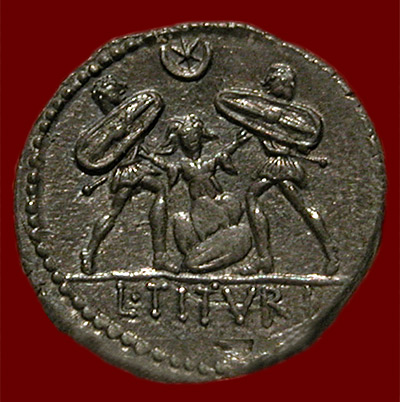
Although out of breath from climbing the steep stone stairs, you are anxious to see the famous saxum Tarpeium, the Tarpeian Rock or cliff from which people convicted of capitol crimes were hurled to their deaths. As you look at the precipitous drop down the cliff side, you agree with Seneca the Elder's vivid desciption:
Stat moles abscisa in profundum, frequentibus exasperata saxis, quae aut elidant corpus aut de integro gravius impellant; inhorrent scopulis enascentibus latera.
There stands a massive cliff sheered off into a deep pit; the slope is roughened with crowded boulders which either crush the body or hurl it on down more violently. All sides bristle with jagged rocks that seem to keep sprouting up. (Controversiae 1.3.3.)
Popular folklore in Rome connected this place with the legend of Tarpeia, whose story is told by Livy. In Livy's traditional version of this story, when the Sabines were attacking Rome, Tarpeia, the daughter of the Roman commander of the Citadel, secretly opened the gates to the enemy, allowing the Sabines to take the Citadel. The Sabines then crushed her to death with their shields, either because she was a traitor or because she had agreed to admit them in return for "what they wore on their left arms" (meaning their heavy gold armbands rather than their shields!). Tarpeia and this cliff were invoked by Roman leaders in times of stress. For example, the Republican coin above (along with a coin depicting the related story of the Rape of the Sabine Women) was issued by the moneyer L. Titurius Sabinus in 89 BCE, during the Social Wars, perhaps as a warning about treachery to the Italian communities that had been allies of Rome for generations but were now rebelling against Roman dominion. Similarly, The moneyer P. Petronius Turpilianus issued a coin with Augustus on the obverse and Tarpeia on the reverse in 19 BCE, when Augustus was absent settling affairs in the East and there was unrest and rioting in Rome, including the execution of a prominent aristocrat, M. Egnatius Rufus, for treason.
There is some dispute among modern topographers about the location of the Tarpeian Rock; it used to be thought that this was on the other summit of the Capitoline hill, but most scholars now argue for a location on the Arx, bringing together the Carcer, Gemonian Steps (the lower part of the Gradus Monetae), and Tarpeian Rock (see plan of the Arx) to form a stage where spectacular Roman dramas of imprisonment, punishment, execution, and exposure were played out before the eyes of the Roman people in the Forum.